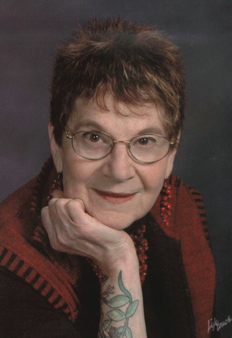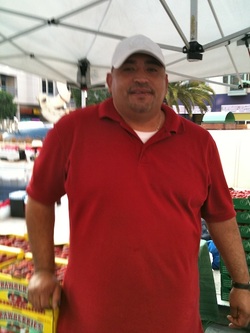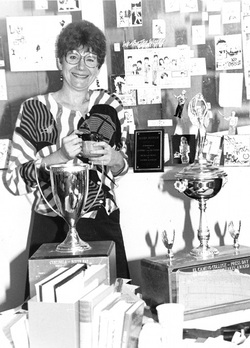 Alison's arm candy As she waved me through the security-check gate at SFO, the lady agent pulled up her pant leg to show me the scaled dragon tattoo curling up her calf. And the other morning a youthful barrista at the West Portal Starbucks took time to explain why he wasn’t sure about getting tattoos though many of his friends had them. He wondered if it hurt. Of course, it hurts. That’s hardly the point. It’s pain that can be put up with, especially if, like me, you orchestrate your pain to the strains of the ‘Buena Vista Social Club.’
Something about seeing the tattoo of an intricate green vine with pink flowers that looks like a fuchsia and runs from my elbow to my wrist on my right arm of a “woman-of-age” encourages that kind of show and tell. But not everybody, seeing the decorative plant, responds with admiration. Some express indifference, disdain and/or disbelief. Yes, responses have been mixed, but basically they divide between “Wow, what inspired you? And “Good grief, what possessed you?”
My first “good grief” greeted me immediately following my first two and a half hour session, when I came into the lobby of my condo on Gough street with my arm wrapped in plastic. The lady who lives on the floor above me expressed shock and wondered where I planned to park my motorcycle. “I’m the same woman you saw this morning,” I said to her, “and I still have one parking place like every one else in the building.”
My favorite “Good grief” occurred at the opera one evening when the glittery lady sharing the armrest to my right looked at my vine and said, dismissively, that it’s all very well for now, the fad and all but since it is permanent what will you do when you get older. I smiled and pulled up the sleeve on my unadorned left arm.
I’m not sure why I waited 67 years to get ink, perhaps it was the proximity of the tattoo parlor to my home. At some level I reasoned that carting me home if I succumbed to pain or paint fumes wouldn’t be difficult.
But the desire to mindfully decorate and commemorate the right side of my body goes back to being the three-year old whose arm went into the old-style wringer of a washing machine, got stuck and was dreadfully injured, requiring more than a month of hospitalization in traction and skin grafts from my right leg to the arm in the hope they would make the resulting scar less visible.
The tattoo was to be my conscious tribute to childhood pain and perceived ugliness, to the helplessness I felt in the hospital, the awful pain, fear and loneliness. Doctors used to blurt things out in front of children, such as she will never have the full use of the arm. The scars on her leg will never fade, but no one will notice them.
Additionally, I wanted a tribute to plants because as a docent-in-training at the San Francisco Botanical Garden and Arboretum, I learned that plants just do what they do to continue the species, and I admired that unemotional purposiveness. No mood swings in the arboretum as plants coexist without jealousy or vanity. Admirable, don’t you think?
And finally, I chose to make a statement about aging, to say that regardless of what we endured early, life continues full of surprises, and much joy lies in being a late bloomer
 Pedro at the Fillmore & O'Farrell Farmer's Market The strawberry man is setting up. It isn’t 9 a.m., the advertised time for the start of the Farmers Market at Fillmore and O’Farrell in San Francisco, but the strawberry man is happy to see me, although I’m not certain I’m the me he sees. Whoever he thinks I am, he is happy, declaring he greets me every Saturday and for this reason he will sell me $7 worth of strawberries for $5, which is all the pocket money I have. I accept his gracious offer, choosing to be whoever he thinks I am because he wants to accommodate the me he thinks is me. He says my early morning money will go directly into his 10-year-old daughter’s college fund. Already she plans to go to college when she grows up. This makes me happy, because the me who is me taught high school for 31 years. I appreciate pledges of education, particularly when the future graduate will be an under-represented minority.
Having spent all my pocket money, I head back across Fillmore to my car in the Safeway parking lot where Doug, my morning coffee-drinking companion at Starbucks, is smoking a cigarette and talking to a friend. When I get to my car, I am unable to leave. Part of me wants to take the strawberries, all the strawberries, and drive away fast, but another part says I got a deal because I am not who I think I am, at least to the strawberry man. And when I imagine myself someone other than me, I am not a person who drives away fast, but a person who shares what comes to me, especially by mistake, with someone else, in this case Doug. I hesitate. I try to pack my strawberries and leave, but I can’t, so I untie the yellow plastic bag and rearrange the berries to fit their three plastic containers. I take one of the baskets to Doug and hand it to him. “For me?” he asks. I nod. Then I get in my car and go home.
I am making the most of my mistaken identity to be someone I really like. Rather than a woman besieged by self-doubt and frequent bouts of self-loathing, I am a woman who is at the strawberry man’s stand each Saturday at the Farmers Market on Fillmore and O’Farrell. This is not a bad person to be. Certainly she is enough on this Saturday morning at 7:30 a.m.
And while to myself I may have been the woman with a surprisingly decent cholesterol level leaving the St. Mary’s Hospital building on Shrader and Fulton, to the blind man trying to go in on Wednesday, I was a godsend. I saw him tapping against the side of the rounded front of the building, unable to navigate the confusing steps. He heard me and asked if this was the building and I said yes and went to him. He positioned himself at my arm, explaining it was his first visit to this doctor and no family member could go with him. We went in and he asked me to find his doctor and I did, checking the listings in the lobby while he waited inside the entrance. Suite 400, right near the door. I reconnected with him and guided him into the office and to the admissions desk, leaving him there as he thanked me with profound gratitude.
And that gratitude was reciprocated because I am pleased to be the person I have just been. This identity is a gift from him. And when I tell my therapist that this encounter has been the high point of my week and she rephrases my words as therapists do, saying I had helped him, I said no. “Help” is not the word I want to interpret what transpired between that blind man and me. The word Help sounds too unequal. For in that transaction between us, I felt given a gift. Let me hear her words reflect that fact. Let me hear her understand how that blind man allowed me to be my best self, an unquestioningly kind person who expected no benefit from right behavior. He allowed me that experience of compassion, an experience I can apply to myself. He knew nothing about the me I think I am. He saw me not at all.
When it comes to self-love, I tend to apply an altogether different standard than the one I use for blind men, strawberry men and coffee-drinking companions who may or may not be homeless. Over the years, in and out of therapy, it hasn’t seemed to matter how many reasons buried in childhood I have accepted as plausible explanations for why I judge myself so harshly and am so unkind to the me I think I am. But examples of compassion do make an impression. Because a blind man needs me, whoever that is, to get to the urologist’s office I know the look of compassion. And I benefit because the strawberry man sees me as someone else. And his daughter is $5 closer to college while Doug goes home with strawberries.
Clearly, expressions of love and compassion don’t rely on identity; they don’t need you to know who you think you are.
 Win some, lose some. Narbonne HS in the late '80s I’ve heard it said that hindsight is 20-20. With this insight in mind, I have to re-examine my 31 years of secondary school educating with an eye to learning why I was never named Teacher of the Year.
Those first several years in the classroom as a youngster, I can easily see why no one nominated me. Too many mistakes, warnings about unsuitable behavior, about being too close to the students or wearing clothing that gives the wrong impression. Heels too high, skirts too tight, necklines maybe a mite revealing.
Then those years fall behind. Shoes become sensible, pants that reveal no shape replace skirts, blouses droop over waistbands. Now immune from any interested eye, I invite no inappropriate attention. But still no nomination.
Apparently, there’s more to qualifying than transforming from vamp to frump. I have been too superficial in regard to what will garner the votes necessary to be elevated above the ordinary wielders of chalk and erasers who comprise my teacher peers.
One year, I identify the exact moment that any hope of being hailed the queen sails out the window. The committee has come to evaluate my fourth period eleventh grade English class, despite the fact that my real claim to acclaim is in the journalism program which meets sixth period.
Equipped with an impressive lesson plan I have divided the class into groups who have been instructed to discuss a poem by Gerard Manley Hopkins with an eye to pooling insights. Unfortunately, Nikita, despite instructions to look interested in the poem, decides to replenish her eye make up and redraw her lip shape before slathering on moist pinkish lip-gloss. Members of the committee note the aberrant behavior and can’t see how it relates to any part of the lesson plan. Later the report will come back informing me that I lack class control.
When I learn how harshly I’ve been judged, I tearfully face the offending class and blame them. “This year, because of you,” I say, pointing at the fifteen-year olds, “I will not be Teacher of the Year.”
During sixth period journalism class, I retell the story of failure to my sports editor, Danny. “They said I lacked control,” I sobbed.
“What’s the big deal” he said, not denying the fact, “you’re still a good teacher.”
Therefore, if excellence does not hinge on appearance and classroom control, which of my experiences in the classroom should have made me a shoo-in to win Teacher of the Year?
Hear some of my innovative techniques and you will understand why I always imagined myself Teacher of the Year.
I think my inclusion of blame placing in the journalism curriculum for beginning student reporters qualifies not just as a ground breaking approach to teaching self assertion and building confidence, but as a real world lesson for adulthood. The secret is to blame someone else for anything that might be traced to you.
The actual classroom practice for the art of placing blame can be fun and instructive to watch. The Teacher of the Year committee would see students eagerly pointing at each other while providing anecdotal evidence linking errors, misinterpretations and mistake with someone else, whom they must name. Quickly they pass the buck. The more inclusive the practice becomes, the fewer people remain to take responsibility for anything that goes wrong ever. This lesson can be taught in conjunction with the passive voice. One exception must be noted. The teacher is never to blame.
I would invite the Committee to view my student editors at work as they sit at their computers formatting pages and editing stories with one hand extended above their heads, fingers forming an “L” shape. This signal of “low self esteem” temporarily exempts them from brow beatings I frequently employ to reinforce heuristic concepts they may not have heeded earlier in classroom instruction. Unlike the previous lesson where the teacher is exempt from blame, the teacher can do a double handed arm lift and raise two “L’s” in the face of student protests. However, that information would not be shared with the Committee.
Finally, because there has to be a finally, despite a myriad of effective teaching techniques that should have qualified me to be Teacher of the Year or at least the recipient of a school-wide nomination, we come to a demonstration of consummate self control that would have clinched the award if anyone on any committee had seen it.
I invite you to imagine a sports writer arriving back to the classroom from covering a volleyball game. He has written the opening paragraph to the story, the “lede” as we call it in journalist lingo. He is a tall blonde young man who will later make his acting debut in Gilbert and Sullivan’s “Pirates of Penzance” but right now he is meeting a deadline and the sports editor has held a space on the page for his story. When I read what he has written I am dumbstruck. He has described the uniforms of the opposing team in the opening graf.
Unfortunately, he doesn’t remember the final score of the game and he thinks the Gauchos, who is our team won or maybe lost. What are we to do? Deadline is approaching. The print shop we use in a nearby town closes at 10p.m. and someone will have to drive the paper there, so I can pick it up the next morning for distribution that day. It isn’t as if he doesn’t know better. I have told him many times what constitutes a sports lede.
Enter the committee. They see me take the young man by the arm and guide him into a desk in the classroom. I sit at an adjoining desk and I whisper to him that this is the worst story I have ever seen and he is failing the class. He whispers back his chagrin that he has failed us all. He suggests we fill the column inches reserved for his volleyball coverage story with a picture of the team shot for the yearbook which he can get his hands on. In the quietest of voices he begs me not to fail him so he has the grade point average to get into the college of his choice. Still in the lowest of whispers I tell him it is too late and he should have thought of that at the volleyball match. Because we are whispering, the committee will never see anything but a calm calamity handled with adult aplomb.
Have I ruined a young man’s life because he botched a volleyball story? Will the paper go to press on time? Will someone else pick it up in the morning and drive it back to school in time for morning distribution? Will the sports editor get on the phone and get all the details from his sister who plays on the team? If the committee wants answers to these questions, it can reconsider my qualifications for Teacher of the Year.
|



 RSS Feed
RSS Feed